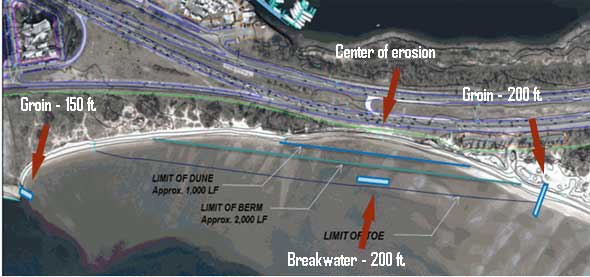Plumb Beach Restoration Gets Green Light, But Horny Horseshoe Crabs Will Delay Project
After more than a decade of battling government bureaucracy, members of the Sheepshead Bay / Plumb Beach Civic Association were treated to some welcome news at their meeting last night: Councilman Lew Fidler announced that an agreement had been reached to restore Plumb Beach, with long-term measures to be implemented against future erosion.
However, the project won’t get as early a start as some had hoped, as the area will be overrun by mating marine life.
AN AGREEMENT MADE
Fidler announced that the Army Corps of Engineers, along with the slew of public agencies responsible for the beach’s oversight, gave the green light to a $5 million plan to restore the beach and protect it for decades to come.
“Quite frankly, the entire City of New York owes this community and this civic association a thank you,” Fidler told the group. “If Plumb Beach had disappeared and the Belt Parkway went with it, it would’ve been something that would’ve been felt throughout this city. Everyone going out to JFK [International Airport] would have felt it. Everyone traveling out to Long Island would’ve felt it. Everyone traveling out to Staten Island would’ve felt it.”
In addition to cheers from civic members, Community Board 15 Chairperson Theresa Scavo praised the announcement.
“Thank God. Thank God. Thank God it’s proceeding,” Scavo said. “We’re saving the Belt Parkway. We’re going to have another beach in the community. That’s all that matters.”
SO WHAT’S THE PLAN?

The Army Corps of Engineers’ plan calls for 100,000 cubic yards of sand to be brought in from Ambrose Channel, said Dan Falt, the project manager for the U.S Army Corps of Engineers. The sand will be pumped in through a pipe from a dredge boat and moved around with a bulldozer. After adding the sand, they will construct two terminal groins, and install a breakwater.
At about 200 feet long, a breakwater is a long, narrow stone island that would run parallel to the beach, and will be located at the center where most of the erosion occurs. Breakwaters are designed to reduce the amount of sediment that’s brought into the beach, as well as weaken waves before they crash into the shore.
This plan was the most comprehensive of three proposals made available for public comment in February 2011.
“We’re very excited that we’ve reached an agreement, and once we sign it we’re going to work as fast as we can to execute it and get this work done,” Falt said. “Hopefully, by this time next year, we’ll have a protected Plumb Beach.”
DELAYS ALREADY PREDICTED
The beach has been rapidly eroding since 1992, the last time new sand was dumped in the area. The shoreline slowly receded until 2009, when a nor’easter ripped through the area and storm surges reduced the beach to within several feet of the Belt Parkway – destroying the bike path on its way.
Though local activists like those at the SP/PB Civic Association had issued warnings about the erosion for years, government agencies only began taking the issue more seriously once the waters threatened to undermine the adjacent highway.
Now there’s a plan in place, but Falt noted that not every element was in order. The agreement has not yet been signed – though they expect that to be done by the end of the month.
Federal funding for the project – which accounts for 65 percent of the $5 million price tag – has also not yet been secured, Falt said. However, the Army Corp expects to receive notification assuring them of the funding soon.
Following that, engineers will begin drawing up specific designs for the groins and breakwater. The various contracts will then go out to bid.
WHAT ABOUT THOSE HORNY HORSESHOE CRABS?
While Councilman Fidler said he hoped the project would begin in the spring, Falt said that wasn’t likely.
The Army Corps contracts won’t be awarded until May or June, Falt said, and that means progress will be hindered by nature, not bureaucracy.
Plumb Beach and the entire Gateway National Recreation Area is a protected mating ground for horseshoe crabs. Horseshoe crabs use beaches like those in Jamaica Bay as their mating grounds because their location in a bay or cove protects them from surf. They come ashore in our area throughout the summer, during new and full moons, and deposit thousands of eggs in the sand at once before returning to the waters.
That means the public won’t see any construction kick off at the beach until the end of the summer or early fall.
That perplexes Scavo, who worries about the city infrastructure surrounding the habitat. She noted that, given the project’s history, a small delay could develop into a much larger one.
“The Belt Parkway we’re not worried about, but we’re worried about some mating horseshoe crabs?” she said. “I think this project should be a little expedited.”



